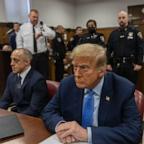Five things learned at NFL combine
— -- A Siberian Express blew through Indianapolis last week and sent temperatures plummeting below zero. Inside Lucas Oil Stadium, however, the NFL scouting combine was red hot with strong performances.
Of the 309 position players in attendance, 258 ran, and many posted impressive times. With such a high percentage of the pro prospects participating, scouts and general managers head into the pro day workout schedule with plenty of good information already in hand.
There were very few surprises at the combine. The top prospects confirmed their positions, and the No. 1 overall pick was pretty much locked down.
Here are the five things we learned at the 2015 combine.
1. Tennessee Titans are on the clock: Coming into the combine, the Tampa Bay Buccaneers appeared to be leaning toward selecting Florida State QB Jameis Winston with the No. 1 pick. Now, barring an off-the-field incident or an injury, Winston to Tampa Bay appears to be a lock.
Winston had an exceptional combine. By working out Saturday, he showed he's the best thrower in the draft -- even though medical people found a weakness in his right shoulder. Behind the scenes during his interviews, Winston showed he has a great ability to pick up plays on the chalkboard and discuss them. With Winston likely going to Tampa Bay, the Titans, unless they trade the No. 2 overall pick, have the option of taking Oregon QB Marcus Mariota or one of the draft's top defenders (USC defensive lineman Leonard Williams or Nebraska LB Randy Gregory).
Overall, the willingness of the top quarterbacks to throw raised their ratings. Mariota was a little off on a couple of long throws, but considering he rushed back from a shoulder injury, he made a case to be at least the second quarterback in the draft and locked up a top-six rating. A great debate is shaping up for the No. 3 quarterback slot. With 10½-inch hands, Brett Hundley of UCLA showed a strong arm. Bryce Petty of Baylor had an effortless throwing motion that improved his stock. Brandon Bridge of South Alabama, Sean Mannion of Oregon State and Cody Fajardo of Nevada also did well.
2. Another great year for wide receivers: Only five of the 44 wide receivers at the combine didn't run or work out, so scouts and general managers don't have to travel around the country chasing down receivers for 40-yard dash times. The only first-round prospect who might have hurt himself a little was Michigan's Devin Funchess, who ran a 4.7-second 40. Overall, the impressions of the receivers were amazing. The tall receivers were fast and caught the ball well.
The big winner was Kevin White of West Virginia. At 6-foot-2 and 235 pounds, he ran a 4.35 40 and had a 36.5-inch vertical jump. If he once was considered toward the bottom of the first round, his ratings could jump to the middle. It's not out of the question for him to be drafted in the top 10. Last year, Odell Beckham Jr. was the star of the combine and ended up being the NFL Offensive Rookie of the Year. Amari Cooper of Alabama appears to be the top receiver. He ran a 4.42 40. It will be hard for the Oakland Raiders to pass on him with the No. 4 pick. At 6-2, Devante Parker of Louisville helped his first-round stock with a 4.45 40.
The abundance of talented receivers should have an impact on the free-agent market. It could cause teams to release high-priced receivers such as Mike Wallace, Brandon Marshall and Percy Harvin in order to pick up some of these young receivers.
3. Timing is everything on defense: Teams switching to the 3-4 defense, such as the Chicago Bears, Denver Broncos and Buffalo Bills, can benefit from this draft. There could be as many as nine defensive linemen or linebackers taken in the top 20, and most of those players are good fits for the 3-4.
The Broncos may not need a linebacker because they have Von Miller and DeMarcus Ware, but they'll likely take a close look at the defensive linemen. The Bills have enough good players in their front seven, but the Bears could be all over this class of linebackers and defensive linemen. They tried to upgrade a 4-3 defensive line last year. Now, defensive coordinator Vic Fangio needs to revamp the entire front seven.
Linebacker/defensive end Vic Beasley of Clemson was the big winner over the weekend. He ran a 4.53 40 and bench-pressed 225 pounds 35 times. Gregory of Nebraska did well, running a 4.64. Dante Fowler Jr. of Florida ran a 4.6 40. Shaq Thompson of Washington ran a 4.64. And then there's Danny Shelton of Washington. The 6-2, 339-pound defensive tackle ran a 5.64 40 and looked so much like Haloti Ngata that he should go in the top 10.
The abundance of talented 3-4 players could cause some teams to steer clear of free-agent pass-rushers such as Brian Orakpo, Pernell McPhee, Derrick Morgan, Brandon Graham and Jabaal Sheard.
4. Running backs didn't disappoint: What is considered the best running back class since 2008 had solid performances Saturday. Wisconsin's Melvin Gordon bolstered his chance to become the first back since 2012 to go in the first round. He ran a 4.52 40. No back set land-speed records, but just about everybody secured a good rating. A dozen backs could go in the top three rounds. Jeremy Langford of Michigan State might have been the big winner. He likely improved a third-round grade by running a 4.42 40.
Todd Gurley of Georgia seems to be well along in the healing process from ACL surgery. The only loser might have been David Cobb of Minnesota. Cobb injured a quad while running what turned out to be a 4.81 40. His pro day is March 2, which might be too soon for him to run again. At some point, teams will need to get a time on him. He has a third-round grade.
5. Draft is weak up the middle: Going into the combine, tight end, inside linebacker and safety were considered three of the weaker positions in the draft. Based on the workouts Monday, cornerback also has to be a concern. Cornerback times were slow. Sure, Trae Waynes of Michigan State put himself in position to be a top-10 pick with a 4.31 40 and Byron Jones of Connecticut wowed everyone with a 12-foot, 3-inch broad jump and a 44.5-inch vertical jump, but the rest of the defensive backs group struggled. Even during the NFL Network broadcast, commentators were joking that analyst Deion Sanders might have been the fastest corner on the field. Marcus Peters of Washington (4.53), P.J. Williams of Florida State (4.57) and Quinten Rollins of Miami (Ohio) (4.57) remain lower first-round prospects, but their times didn't boost their stock.
Landon Collins of Alabama remains the only safety meriting a top-50 selection. No one else really jumped up. Only three defensive backs ran sub-4.4 40s. Maxx Williams of Minnesota (4.78) and Clive Walford of Miami (4.79) remain the only tight ends rated in the top two rounds. No one else stepped up. Eric Kendricks of UCLA had a 4.61 40 to secure his ranking as the top inside linebacker.




